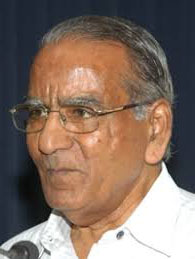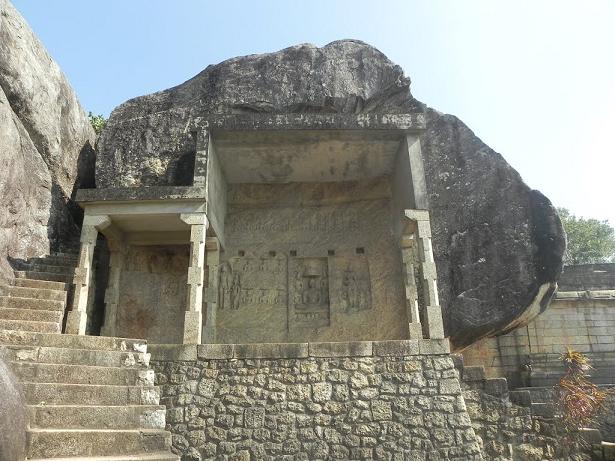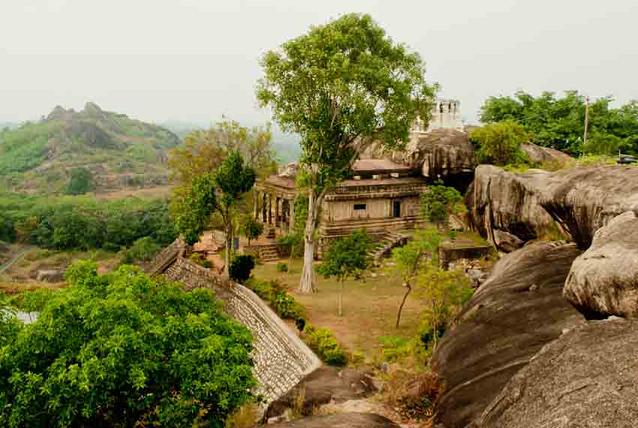Ancient Jain Temples of Tamilnadu
 |
By Mr. Dulichand Jain, Chennai
The Jin religion is one the oldest religions of India and it is an integral part of Indian culture and heritage. in the excavations of Mohen-jo-dero and Harappa, statues in kayot-sarga mudra (the Meditation posture of Jain ascetics) were found.
More than 2500years have passed since the Nirvana of Sramana Bhagwan Mahavira, who was the 24th and last Tirthankara of this period.
 |
Right from the ancient times, the Tamil Land has been a confluence of different religions. Vedic, Buddhism and Jainism spread their influence here and all enjoyed patronage from the local kings. At the advent of 3rd century B. C. during Chandragupta Maurya's period there was a famine for twelve years in North India, owing to which the king accompanied by his Guru Srutakevali (highly learned in scriptures) Bhadrabahu and thousands of disciples, came over to South India and they had made their stay at Sravanabelgola in Karnataka state. From Karnataka, Vishakh, a renowned Jain Saint, accompanied with his thousands of disciples came to Tamilnadu where they were warmly received by the local people.
Already the non-violent culture propagated by the first Tirthankara Lord Rsabhadeva and other Tirthankaras was in vogue in Tamilnadu and hence these ascetics did not find any difficulty in continuing their religious practices smoothly. Jain religion was highly influential amongst the common masses right from the 3rd or 4th century B. C. till 8th century A. D. This has been substantiated from the inscriptions found in the caves of Puddukottai, Madurai, Ramnad and Tirunelveli district. The Jain saints and nuns travelled all over Tamilnadu and a few cities, such as, Maduri, Kaveripoompattinam, Tiruchirapally, Kanchi, Kumbhakonam, Puddukottai, Kadalore, Thiruparruttikundram and Mylapore, become very important centers of Jain heritage.
During this lengthy period of more than 1000 years of Jaina influence in Tamil Land, many Jain Acharyas and Saints achieved popularity here. Tolkappiyam is the oldest book of the Tamil language. This was written by a highly spiritual (Pratimadhari) Saint Tolkappian. During the first century A.D. the great saint Thiruvalluvar produced his famous work "Thirukural" which is considered as fifth Veda in Tamilnadu. A few scholars are of the opinion that he was 'Elacarya' and known as'Kundakundacarya' in the Jain literature. During the second, third A. D. the greatest Sramana (mendicant) Ilango Adigal became very popular. He was the younger brother of Chera king Shenguttavan and he is credited as the writer truly sanctified by the presence of very many eminent and powerful Jian Acaaryas and Saints, such as , Akalanka, Ganinanthi, Pujyapada, Sarvanandi, Gunavirassagara, Matisagara, Vamanamuni, Thirutakka-Thevar, Tholamozhi Thevar and others.
It is in this conductive atmosphere the highest development of Jaina literature, art music and architecture blossomed. Saint Thirutakakathever wrote the great epic Jivaka-cintamani. The writer of the famoust Tamil grammar Nannual was Bhavanandi who was a Jain. Gundhirapandita wrote Neminatham in the praise of Tirthankar Neminatha. The famous Jain work, 'Chudamani' was written by Tholamozhidevar.
The Pallava king Simavarman, Simavisnu, Mahendravarman, Pandya King Nedumaran, Kanchi king Sivakoti and other kings were great patrons of Sramana Dharma and this religion spread widely during their reigns. The patronage was not available due to Bhakti movement during the 8th century A. D. In spite of this Jainism held its way in Tamilnadu in isolated pockets amongst the chieftains and masses.
The vestiges of this ancient Jain culture are still available in the form of caves, temples, rocks, and in literary works. With the passage of time, many Jain temples, rocks, caves, buildings and settlements were destroyed. Even then a few temples are still available and worshipped regularly by the devotees. A few of these ancient temples are listed here to indicate the influence of the Jain community in Tamilnadu.
Ancient Jain temples :
Jinakanchi : This famous tirtha is situated four km. from Kanchipuram at Thiruprutikundram village and is surrounded by high walls. Here beautiful icons of Lord Mahavira and Lord Candraprabhu are installed. At the ceiling of Music hall of the temple beautiful paintings of ancient times and scenes are inscribed. Here eye-catching paintings of the Pancakalyanaka of Lord Rsabhadeva, life story of Lord Mahavira and details of the previous lives of Lord Neminatha are beautifully painted.
This temple was built during the 6th century A. D. in the period of Pallavaa Kings. In 640 A. D. Chinese travellers have described that there were 80 big temples and a big settlement of Jain in this tirtha. King Mahendra Varman and kulottung Chola I gave valuable gifts to this temple. About 600 years ago Mr. Irrugoppa. Dandanayaka, who was a minister of Vijayanagar empire Harihar, constructed a large Mandapam with 20 pillars, This place was sanctified by Acarya Vamana who was a guru of Pallava Kings. Here we can find the foot prints of Puspasena who was a disciple of Acarya Vamana.
Puzhal : This is an ancient and popular tirtha of Tamilnadu. This tirtha is just 2 km. from Red Hills village and 15 km. from Madras. Here a very grand image of the first Tirthankar Lord Rsabhadeva is installed. A grand statue of Lord Parsvanatha is also installed here.
 |
This tirtha is 1500 years old. King Koorumbar of Chola dynasty, who was a great devotee to Jina, constructed the temple. In ancient times, this place was popularly known as ' Puzhal Kotalam'. In the same temple, a very glorious image of Bhagavati Padmavati Devi is also installed. Thousands of devotees come to visit this place. Near the temple, there is a modern choultry and dining Hall.
Jingiri : This pilgrimage centre is situated on a hill near Thirunarunkonde village. This place is twenty km. away from Ulundurpet in South Arcot district. In this temple, grand statues of Tirthankara Parsvanatha and Candraprabhu are installed. There are three beautiful towers in this temple, which are the beautiful specimens of chola architecture.
Here we find caves and stone beds where the Jain Saints had stayed and done penances. These are as old as the 3rd to 5th centuries A. D. From the inscriptions it is found the the successors of Rajaraja Chola I, Rajendra Chola I, Kulottungachola I, Pandyas and Vijaynagar Kings had helped in the development of this area. Princess Kundave, the sister of a Chola king, built a water tank here which is still in existence. On the towers, there are many images of gods and goddesses which are very attractive.
This pilgrim centre was a famous abode many saints. The popular acarya Gunabhadra made this place his abode. His disciple Sri Mandalapurush wrote the Tamil Nigadu "Chudamani" here.
Melchittamur : This tirtha is also famous as Jinkanchi Madam. Here a very grand image of Lord Parshwanatha is installed, which is unparalled in beauty. On the temple towers, attractive images are inscribed. This temple is noted for its artistic sculptures.
There is no doubt at all that this was a great Jaina centre in ancient times. here a statue of Lord Neminatha is also installed. The people here believe that this statue was brought from Mylapore, madras, after the destruction of the temple, which was situated at the place where presently a deaf and dumb school is situated. This place is twenty km. away from Tindivanam. The seat of Bhattarakaji (Head of Jain community) is in close proximity to this temple.
Ponnurmalai : This place is situated 3 km. from Ponnur village, 10 km. from Vandavasi and 40 km. from Tindivanam. Here a beautiful image of Lord Mahavira is installed.
This ancient tirtha was established in the 1st century A. D. At that time the great and influential Jain Acarya Kundakunda had made this place a religious centre for practicing austerities. In the hills nearby even today the foot prints of Acarya Kunkunda are found inscribed on a stone. The serene hilly atmosphere of the place is highly conducive for meditational practices.
Kundakunda was an epoh making Acarya of the Jaina religion. He was a great saint of Dravida Samgha. he has written hundreds of books. His famous book, Thirukural, is and unparalleled work of moral values, practical life and spirituality, which is equally popular not only amongst scholars, but also even amongst the common people. Although he was born at Kondakonda village near Guntakal city in Andhra Pradesh, he choose this place as the abode for his literary and spiritual activities
Tirumallai : This is situated in the Thirumalai village on a 300 feet high Hillock. This village is five km. from Vadamadimangalam village, Railway Station in North Arcot District. It is 150 km. from Madras. Here the statue of Lord Neminatha is installed in the Kayotsaraga (standing in meditation) posture. Below and above the Hill many ancient icons are worth seeing, many springs and caves. In one of these caves, there are paintings of ancient scenes in multicolours. In the same hill, there is a temple dedicated to Lord Parsvanatha where foot prints of Acarya Samantabhadra, Rsabhasena and Varadatta are available.
In ancient times, this was a very famous Jain pilgrim centre, where more that 800 Jain Saints had travelled. During the Chola and Pallva dynastics, this was a very popular pilgrimage centre (Tirthaksetra). The sister of the first Chola king Kundave built a temple dedicated to Lord Vardhamana which is now famous as the Kundavae water Tank. More than 50 inscriptions belonging to Chola and Pallava age are available now. These were written in 1023 to 1042 A. D. There were many Jain settlements here which are mentioned in these inscriptions.
This is the holy land sanctified by eminent Jain Acaryas, such as, Samantabhadra, Rsbhasena, Vardatta, Vadiraja and Ganisekara. Many Tamil literary works were written in this Tapobhumi (holy place). Pandita Gunavira composed Neminathana here. Vachandimallai was also written in this place. This place is called Sravanabelagola of Tamilnadu.
Munigiri : This is situated at Karande village 15 km. away from Kancipuram. Here a grand and attractive icon of Tirthankara Kunthunatha is installed. This place was an important centre for the meditational practices for Jain Saints in the 3rd century A. D. Rajaraja Chola, Rajendra Chola and many other kings gave handsome gifts to this temple. Sri Krsnadevaraya and Ramadevaraya of Vijaynagar empire gifted lands to this tirtha. This was a very prosperous and grand pilgrimage centre till 13 century A. D.
 |
The idols of Lord Adinatha, Parsvanatha and Mahavira are installed in this temple. Nearby, there is a famous Granthagara (library) named Dharmasagara where thousands of books in different languages are preserved. Many manuscripts, works on palm leaves are also found here.
This place was called Munigiri, because it was an important centre of austerities for many Jain Saints. This was the holy centre of Acarya Akalanka. In this place Acarya Akalanka conducted religious dialogues with the Buddhist monks and had won them. In the Bhagwati Ambika temple, an icon of the Acarya, is installed.
Vijaymanglam : This pilgrim centre is situated in the village Vastipuram, which is 20 km. away from Erode. Here a beautiful image of Tirthankara Candraprabhu is installed which is very artistic and attractive. The beautiful tower of the temple looks very grand from a distance and on the pillars and ceilings there are beautiful images of Pancakalayanaka representing Tirthankaras. In this temple the icons of Tirthankara Adi Prabhu and goddess Ambikadevi are also installed. They are worth seeing.
During the 6th century A. D. this was the most developed city amongst the 24 cities of Kongunadu area. (Kongunadu refers to the present western part of Tamilnadu including of Coimbatore and Periyar). Here the ruler was king Kongivelur who built this grand and attractive temple. During the 6th century A. D. this place was an important seat of Tamil scholars. Among them icons of five scholars are still available here. Presently, this place is called Amnesvara temple.
Mannargudi : This tirth is situated at Haridranadi village near Mannargudi which is 34 km. from Kumbakonam. This was constructed in the 12th century A. D. during the region of Chola king. This tirtha occupies special importance amongst the Jain temples of Tamilnadu. Here a very attractive and beautiful image of Lord Mallinatha is installed. Besides many grand images of Sri Sarasvati Devi, Sri Padmavati Devi, Sri Dharma Devi and Sri Jvalamalini Devi are also installed in this temple.
Modern Jain Temples : Many Jain temples have been constructed in recent times. Just in Madras city, 38 temples are constructed in different areas, out of which Juna Mandir, Naya Mandir and the temple at Chulai are very famous. In all these three temples, statues of Lord Candraprabhu are installed. In Mint street, there is a Gujarathi temple, where a grand statue of Lord Parsavanatha is built with unique green stone is installed. Temples are now constructed in almost all districts of Tamilnadu.
An amazing miracle happen on 20th August 1994 at the renovated Candraprabhu Jain Temple at Mint Street in Madras. Six months had passed the constriction of this temple and grand ceremony was in progress. The devotees of the temple completed 1000 Pujas (Aratis) at 7 p.m. All of a sudden , saffron drops appeared from the statue of the lord and soon spread all over the walls and roofs. The white marble walls became yellowish because of the spread of saffron. Thousand of devotees saw this next three days and this news was published in news papers. When the Acarya was asked the cause of this incident, he merely said, "This signifies the progress of Tamilnadu and entire India".
At present, all new temples are constructed from marble and attractive and artistic scenes of history and mythology are inscribed in them. These temples spread the message of non-violence, asceticism, karma, valour, fearlessness and sacrifice to mankind for all times to come.
-----------------------------------------------------
Mail to : Ahimsa Foundation
www.jainsamaj.org
R17111